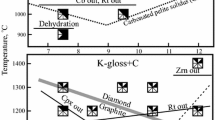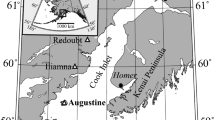Abstract
The stability relations of lawsonite, CaAl2Si2O7(OH)2H2O, have been investigated at pressures of 6 to 14 GPa and temperatures of 740 to ≈1150°C in a multi-anvil apparatus. Experiments used the bulk composition lawsonite+H2O to determine the maximum stability of lawsonite. Lawsonite is stable on its own bulk composition to a pressure of ≈13.5 GPa at 800°C, and between ≈6.5 and 12 GPa at 1000°C. Its composition does not change with pressure or temperature. All lawsonite reactions have grossular, vapour and two other phases in the system Al2O3-SiO2-H2O (ASH) on their high-temperature side. A Schreinemakers analysis of the ASH phases was used to relate the reactions to each other. At the lowest pressures studied lawsonite breaks down to grossular+kyanite+coesite+vapour in a reaction passing through ≈980°C at 6 GPa and ≈1070°C at 9 GPa. Above 9 GPa the reactions coesite=stishovite and kyanite+vapour=topaz-OH are crossed. The maximum thermal stability of lawsonite is at ≈1080°C, at ≈9.4 GPa. At higher pressures the lawsonite breakdown reactions have negative slopes. The reaction lawsonite=grossular+topaz-OH+stishovite+vapour passes through ≈1070°C at 10 GPa and ≈1010°C at 12 GPa. At 14 GPa, ≈740–840°C, lawsonite is unstable relative to the assemblage grossular+diaspore+vapour+a hydrous phase with an Al:Si ratio of 1:1. Oxide totals in electron microprobe analyses suggest that the composition of this phase is AlSiO3(OH). Two experiments on the bulk composition lawsonite+pyrope [Mg3Al2Si3O12] show that at 10 GPa the reaction lawsonite=Gr-Pyss+topaz-OH+stishovite+vapour is displaced down temperature from the end-member reaction by ≈200°C for a garnet composition of Gr20Py80. Calculations suggest similar temperature displacements for reaction between lawsonite and Gr-Py-Alm garnets of compositions likely to occur in high-pressure eclogites. Temperatures in subduction zones remain relatively low to considerable depth, and therefore slab P-T paths can be within the stability field of lawsonite from the conditions of its crystallisation in blueschists and eclogites, up to pressures of at least 10 GPa. Lawsonite contains 11.5 wt% H2O, which when released may trigger partial melting of the slab or mantle, or be incorporated in hydrous phases such as the aluminosilicates synthesised here. These phases may then transport H2O to an even greater depth in the mantle.
Similar content being viewed by others
References
Baur WH (1978) Crystal structure refinement of lawsonite. Am Mineral 63:311–315
Berman RG (1988) Internally consistent thermodynamic data for minerals in the system Na2O-K2O-CaO-MgO-FeO-Fe2O3-Al2O3-SiO2-TiO2-H2O-CO2. J Petrol 29:445–522
Berman RG (1990) Mixing properties of Ca-Mg-Fe-Mn garnets. Am Mineral 75:328–344
Berman RG, Brown TH, Greenwood HJ (1985) An internally consistent thermodynamic data base for minerals in the system Na2O-K2O-CaO-MgO-FeO-Fe2O3-Al2O3-SiO2-TiO2-H2O-CO2. Atomic Energy of Canada Ltd Technical Report 377
Bohlen SR, Boettcher AL (1982) The quartz-coesite transformation: a precise determination and the effects of other components. J Geophys Res 87:7073–7078
Brown TH, Berman RG, Perkins EH (1988) GE0-CALC: software package for calculation and display of pressure-temperature-composition phase diagrams using an IBM or compatible personal computer. Computers and Geosciences 14:279–289
Crawford WA, Fyfe WS (1965) Lawsonite equilibria. Am J Sci 262:262–270
Davies JH, Stevenson DJ (1992) Physical model of source region of subduction zone volcanics. J Geophys Res 97:2037–2070
Deer WA, Howie RA, Zussmann J (1986) Rock-forming minerals, vol 1B. Longman, Harlow UK, p 181
Diessel CFK, Brothers R, Black PM (1978) Coalification and graphitization in high-pressure schists in New Caledonia. Contrib Mineral Petrol 68:63–78
Eggleton RA, Boland JN, Ringwood AE (1978) High pressure synthesis of a new aluminum silicate: Al5Si5O17(OH). Geochem J 12:191–194
Essene EJ, Fyfe WS, Turner FJ (1965) Petrogenesis of Franciscan glaucophane schists and associated metamorphic rocks, California. Contrib Mineral Petrol 11:695–704
Helmstaedt H, Doig R (1975) Eclogite nodules from kimberlite pipes of the Colorado Plateau-samples of subducted Francis-can-type oceanic lithosphere. Phys Chem Earth 9:95–111
Hermes OD (1973) Paragenetic relationships in an amphibolitic tectonic block in the Franciscan terrain, Panoche Pass, California. J Petrol 14:1–32
Hill RET, Boettcher AL (1970) Water in the earth's mantle: melting curves of basalt-water and basalt-water carbon dioxide. Science 167:980–982
Katsura T, Ito E (1989) The system Mg2SiO4-Fe2SiO4 at high pressures and temperatures: precise determination of stabilities of olivine, modified spinel, and spinal. J Geophys Res 94:15663–15670
Lambert IB, Wyllie PJ (1972) Melting of gabbro (quartz eclogite) with excess water to 35 kilobars, with geological applications. J Geol 80:693–708
Liou JG (1971) P-T stabilities of laumontite, wairakite, lawsonite and related minerals in the system CaAl2Si2O8-SiO2-H2O. J Petrol 12:379–411
McMillan PF, Akaogi M, Sato RK, Poe B, Foley J (1991) Hydroxyl groups in β-Mg2SiO4. Am Mineral 76:354–360
Meade C, Jeanloz R (1991) Deep-focus earthquakes and recycling of water into the earth's mantle. Science 252:68–72
Newton RC, Kennedy GC (1963) Some equilibrium reactions in the join CaAl2Si2O8-H2O. J Geophys Res 68:2967–2983
Nickel KG, Brey GP, Kogarko L (1985) Orthopyroxene-clinopyroxene equilibria in the system CaO-MgO-Al2O3-SiO2 (CMAS): new experimental results and implications for two-pyroxene thermometry. Contrib Mineral Petrol 91:44–53
Nitsch K-H (1968) Die Stabilität von Lawsonit. Naturwissenschaften 55:388–389
Okay AI (1980) Mineralogy, petrology and phase relations of glaucophane-lawsonite zone blueschists from the Tavsanli region, northwest Turkey. Contrib Mineral Petrol 72:243–255
Pawley AR, Holloway JR (1993) Water sources for subduction zone volcanism: new experimental constraints. Science 260:664–667
Peacock SM (1990) Fluid processes in subduction zones. Science 248:329–337
Peacock SM, Rushmer T, Thompson AB (1994) Partial melting of subducting oceanic crust. Earth Planet Sci Lett 121:227–244
Råheim A, Green DH (1974) Experimental determination of the temperature and pressure dependence of the Fe-Mg partition coefficient for coexisting garnet and clinopyroxene. Contrib Mineral Petrol 48:179–203
Stolper E, Newman S (1994) The role of water in the petrogenesis of Mariana Trough magmas. Earth Planet Sci Lett 121:293–325
Susaki J, Akaogi M, Akimoto S, Shimomura O (1985) Garnetperovskite transformation in CaGeO3: in situ x-ray measurements using synchrotron radiation. Geophys Res Lett 12:729–732
Tatsumi Y (1986) Formation of the volcanic front in subduction zones. Geophys Res Lett 13:717–720
Tatsumi Y (1989) Migration of fluid phases and genesis of basalt magmas in subduction zones. J Geophys Res 94:4697–4707
Walker D (1991) Lubrication, gasketing, and precision in multianvil experiments. Am Mineral 76:1092–1100
Walker D, Carpenter MA, Hitch CM (1990) Some simplifications to multianvil devices for high pressure experiments. Am Mineral 75:1020–1028
Wunder B, Rubie DC, Ross CR II, Medenbach O, Seifert F, Schreyer W (1993a) Synthesis, stability and properties of Al2SiO4(OH)2: a fully hydrated analog of topaz. Am Mineral 78:285–297
Wunder B, Medenbach O, Krause W, Schreyer W (1993b) Synthesis, properties and stability of Al3Si2O7(OH)3 (phase Pi), a hydrous high-pressure phase in the system Al2O3-SiO2-H2O (ASH). Eur J Mineral 5:637–649
Yagi T, Akimoto S (1976) Direct determination of coesitestishovite transition by in-situ X-ray measurements. Tectonophysics 35:259–270
Yamamoto K, Akimoto S (1977) The system MgO-SiO2-H2O at high pressures and temperatures-stability field for hydroxylchondrodite, hydroxyl-clinohumite and 10 Å-phase. Am J Sci 277:288–312
Zhang J, Liebermann RC, Gasparik T, Herzberg CT, Fei Y (1993) Melting and subsolidus relations of SiO2 at 9 to 14 GPa. J Geophys Res 98:19785–19793
Author information
Authors and Affiliations
Rights and permissions
About this article
Cite this article
Pawley, A.R. The pressure and temperature stability limits of lawsonite: implications for H2O recycling in subduction zones. Contr. Mineral. and Petrol. 118, 99–108 (1994). https://doi.org/10.1007/BF00310614
Received:
Issue Date:
DOI: https://doi.org/10.1007/BF00310614




